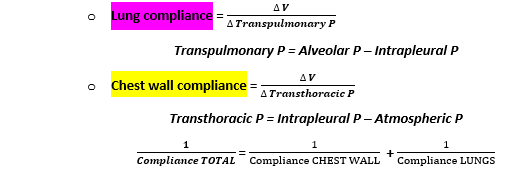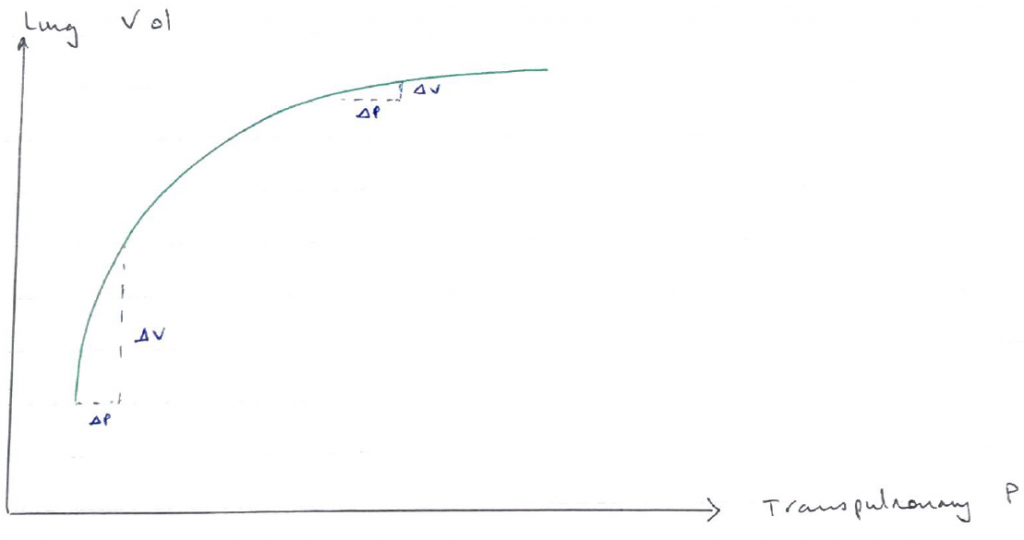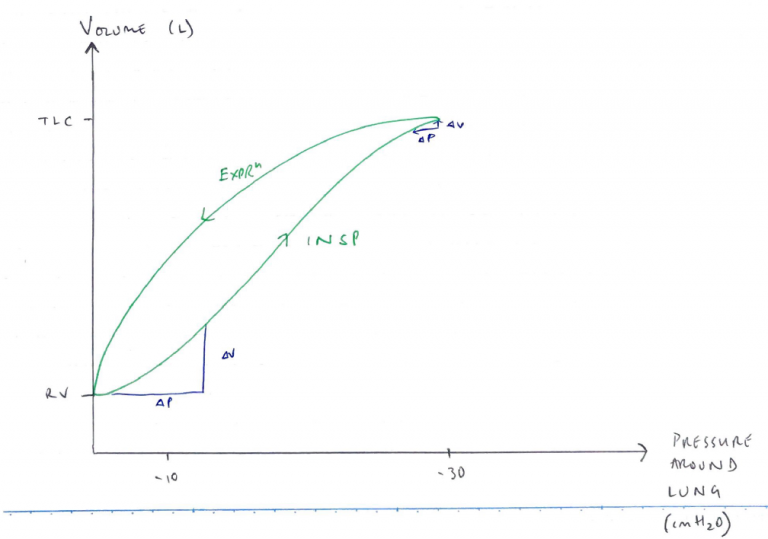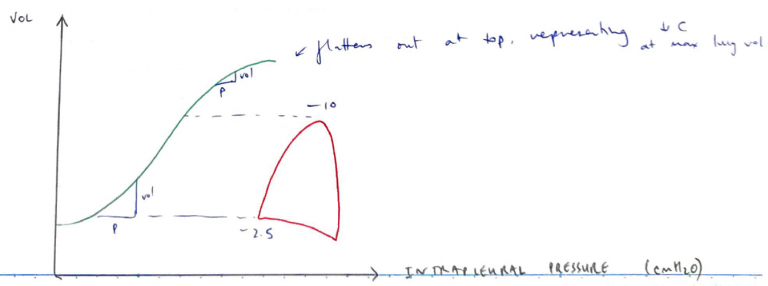F3ii / 22A03 / 19B17 / 17A14 / 14A15: Lung compliance
22A03: Exam Report
Define respiratory compliance, include its components and their normal values (25% marks). Explain the factors that affect respiratory compliance (75% marks)
27% of candidates passed this question.
This question covers a core principle of respiratory physiology and would be expected to have a high pass rate. Most candidates were able to provide a concise definition and distinguish between the different types of compliance.
The imprecise use of terminology often created the impression of a lack of fundamental understanding of this key concept.
Candidates are encouraged to be accurate and concise in their definitions.
A lack of detail in describing the relevant components of compliance and the factors that influence it, immediately limited the capacity of some candidates to achieve an adequate score.
Most candidates provided less than half of these factors and only provided a list rather than explaining how compliance was impacted.
Marks were maximised by dividing the impacts into those that altered lung compliance versus those that impacted on chest wall compliance, and the better candidates explained how and why compliance was affected. Confusion often arose from the imprecise use of arrows with the result that candidates frequently demonstrated an incorrect fact in relation to the direction of the arrow.
Candidates are reminded to take care when using abbreviations or arrows to ensure they are not relying on the examiner to interpret a cause and effect relationship.
19B17: Exam Report
Explain respiratory compliance and outline the factors that affect it.
51% of candidates passed this question.
Answers were generally well structured.
Better answers described lung and chest wall compliance and the pressures which are used to calculate compliance.
Better answers displayed an understanding of dynamic, static and specific compliance and provided a reasonably comprehensive list of the physiological factors affecting chest and lung compliance.
17A14: Exam Report
Define respiratory compliance (20% of marks). Describe the factors that affect it (80% of marks).
54% of candidates passed this question.
This question was generally well answered with good structure.
14A15: Exam Report
What is lung compliance and how is it measured?
34% of candidates passed this question.
There was a good understanding of the definitions of compliance but many candidates failed to clearly demonstrate an understanding of the difference between static and dynamic compliance.
Many candidates had little knowledge of how compliance is measured. It was expected that descriptions of methods to measure static and dynamic compliance would be provided.
There were frequent errors in descriptions that were provided.
F3ii / 22A03 / 19B17 / 17A14 / 14A15: Define compliance (static, dynamic, specific), its measurement, and relate this to the elastic properties of the respiratory system
Static Compliance
- Compliance at no flow
- Measured by consecutive oesophageal P measurements (which is surrogate for intrapleural P) & mouth P (when glottis is open mouth P = alv P)
- ∴getting your values for transpulmonary P = Alv P – Intrapl P
- Maximal inspired breath
- Breathe out into spirometer at 500mL increments
- Small pauses to allow lung stabilisation
- Plot curve P vs Vol
- At low lung volumes, lung very distensible
- At higher lung volumes, lungs reach limits of their distensibility
Dynamic Compliance
- Compliance during respiratory cycle
- Measured with Spirometry
- Static compliance always > Dynamic compliance
- Because you need greater P for the same volume ∆ because the resistive forces need to be overcome quicker
- Also explains that ↑RR will ↓Dynamic compliance
Specific Compliance
- Compliance / FRC = 0.05/cm H2O
- Removes lung size so you can compare patients
Hysteresis
- Compliance is less on INSP than EXPR
- Occurs because on INSP you need more pressure to overcome ST forces & recruit additional alveoli
Importance of Compliance
- Determines the WoB for gas exchange to occur
Factors Affecting Compliance (Lung factors & CW factors)
Lung Factors
- Lung Volume
- Surfactant
- Elasticity
- FRC
- Gravity
- Blood volume
Surfactant
- Surface tension = tension produced across the surface of a liquid by the attractive forces b/w the H2O molecules on the surface
- Described by Law of LaPlace for a Sphere
- ↓radius = ↑collapsing P = ↓compliance
- Surfactant = amphipathic molecule which ↓ST of a liquid in which it is dissolved
- Surfactant ↑ r = ↑ Compliance
- Loss of surfactant (ARDS, pulmonary oedema) = ↓compliance
FRC
- Compliance is greatest at normal FRC
- FRC = 30mL/kg
- Any ↓ FRC (↑ age, supine) or ↑FRC (PEEP) will ↓compliance
Intrapleural P (due to lung weight)
@ APEX
– 10cm H2O
↓
Greater denominator
↓
∴ ↓ compliance
@ BASE
– 2.5cm H2O
↓
Smaller denominator
↓
∴↑ Compliance
Blood Volume
- ↑ blood vol = ↓ compliance
Chest Wall Factors
- All ↓compliance
- ↓elasticity of SW (burns)
- Anatomical abnormalities (byphasic) because ↓ lung volume
- Muscle disease; because ↓ability to generate a more – ve intrapleural P
- Author: Krisoula Zahariou



